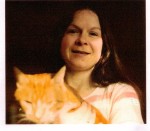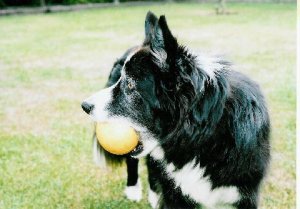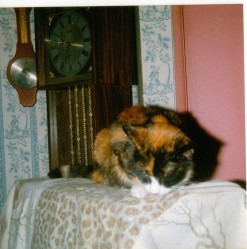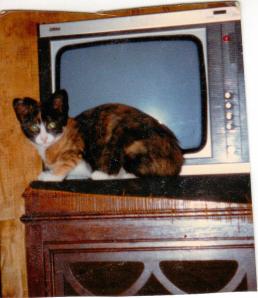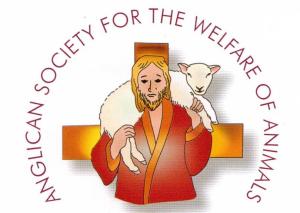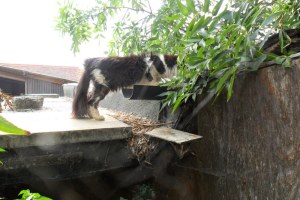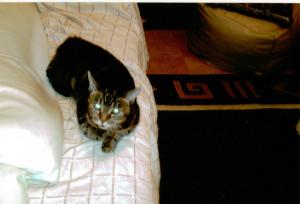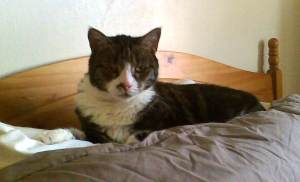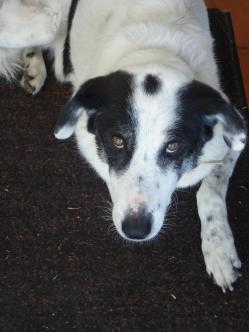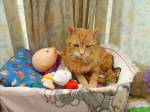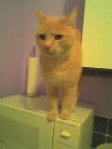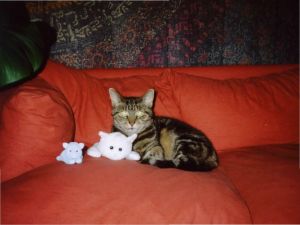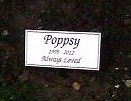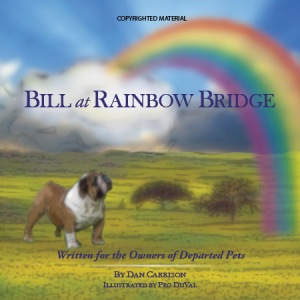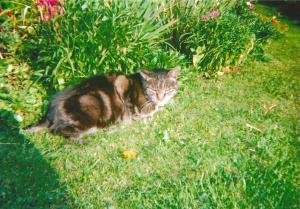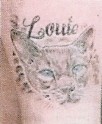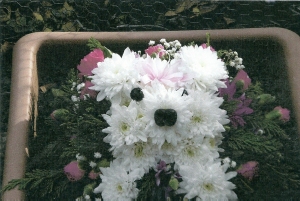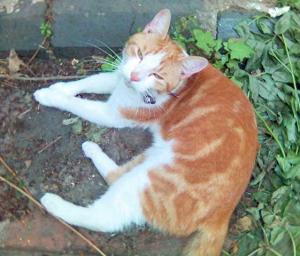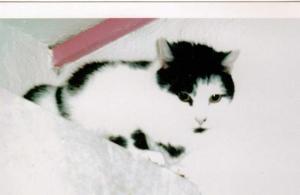SEASON’S GREETINGS
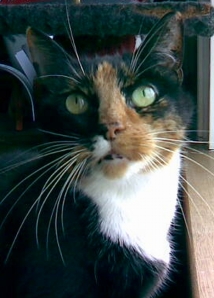
This is a “Bumper Edition” as there was no newsletter in September. From now on, it may not be possible to produce regular 3-monthly newsletters, but they will continue on a slightly irregular basis. However, the service remains the same, so please do get in touch if you need help. Details available on request
Tribute to MUMIA
It is the end of an era. On 12 September 2013, we had to say goodbye to Mumia, the last remaining sister in the litter of 1995, from my son’s cat. (See also Newsletters nos. 46 and 47 for tributes to her sisters, Poppsy and Krishna).
I always thought Mumia would go first, as the others seemed more robust, but she outlived them all. (Her sister Prissie went first, aged 12, then Poppsy and Krishna aged 16). Mumia reached the grand age of 18 years and 3 months, about 88 in human terms.
When she was very young, she had those round, staring eyes that some kittens have, and she was very cheeky. I remember repeatedly spraying her with a soft jet of water to discourage her from eating my plants, but she just stared at me, getting wetter and wetter; I rather think she enjoyed it! She did not stop eating the plants till she grew out of it of her own accord.
She was one of the glossiest and most prettily-marked cats I have ever seen.
She was quiet but managed to get her own way by subtle means. Like her sisters, she objected to being picked up but condescended to be stroked and made a fuss of. I think there might have been feral blood in them, as they were rather manic – and affectionate only on their terms.
As she grew older, she remained beautiful but developed some health problems, including hyperthyroidism, for which she had tablets. I managed to persuade her to eat them by disguising them in cheese spread or vegetarian yeast pâté, both of which she loved. She got wise to this, however, and sometimes refused to eat the mouthful which had the tablet in. I then had to resort to the ‘old-fashioned’ way of shoving the tablet down her throat. This did not hurt her, but was an affront to her dignity. She Was Not Amused.
In her later years she gradually developed a habit of miaouwing constantly, for no apparent reason, which vets believe is characteristic of a condition equivalent to a kind of dementia in humans. She also required feeding, instead of twice a day, ‘little and often’ – very often. Five minutes after nibbling at her tea, she would demand more – and five minutes after that, virtually all evening – starting up at exactly the same moment as particular television programmes we wanted to watch! (We could not leave food down for her to browse at leisure, as Henry and Sammie would vacuum it up and they need to watch their weight).
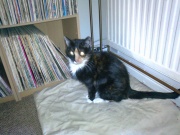
Hyperthyroid cats feel the cold, so Mumia was delighted when we got her 2 heated blankets – one for upstairs and one for downstairs. Imagine her outrage when she discovered one day during the Summer heatwave that I had Taken Them Away! Her angry miaouw demanded that I reinstate them – at once.
Gradually her appetite began to diminish and she grew quieter. She took to sitting on the settee with her front half raised and her front paws on the armrest. I wondered afterwards whether this was an indication of the beginning of the end.
Her breathing became laboured and we had to take her to the emergency vet one expensive weekend. While in the surgery, her breathing returned to normal.
To our relief, tests showed nothing untoward in her lungs and heart, and no tumours were felt. The vet advised a check-up at our usual practice, so we took her the following day. Her thyroid levels were found to be raised, and we were advised to increase the tablets and bring her back in a week for further tests.
But it was not to be. Her appetite did not improve; she was unnaturally quiet and her breathing got worse, till it was laboured all the time. On that final appointment, the vet said she thought there might be fluid in her lungs. There was, sadly, only one thing to do………………
*
The young ones, Henry and Sammie, both seemed to miss Mumia in the very early days, especially Henry, as he was close to her in her declining weeks. (He would lie down near her and, when she allowed it, he would lick her head). Since she has gone, he has also been doing strange things like looking at things I can’t see, sniffing the floor, and on occasion darting from front door to back door, looking puzzled, not exactly scared but rather wary and surprised. It would indeed be wonderful if he could tell me what he was seeing.
The other day I heard a miaouw which I am sure was not Henry or Sammie; Peter didn’t hear it, though he was nearer to where it seemed to be coming from. I like to think it was Mumia, letting us know that she is still around in a house that seems now to be unnaturally quiet.
Debby

As with all our cats who pass, we buried Mumia in our garden and, as always, I rang to place an order for a memorial plaque [pictured above] from ‘Pets in Paradise’ – a small family business run by Carol and Ian Wallace (See DF32 for short article about them). Carol mentioned that she also had suffered a recent loss – of a remarkable goldfish, who was responsive and with whom she had had a long-term relationship. She had suffered the all too common lack of understanding from people she knew – who could not understand how she could be so affected by his loss. She has written the following tribute to him for Departed Friend, and also to two other special friends she has loved and lost. All these tributes appear below.
Pets in Paradise have a large range of memorials, caskets, coffins, etc. to help ease the grieving and commemorate our lost loved ones. But above and beyond all this, they offer a sensitive, caring service from people who truly understand.
*
Pets in Paradise
(Carol & Ian Wallace) 27 Naunton Park Road, Cheltenham, Glos. GL53 7DG. U.K. tel: 0845 643 1891. www.petsinparadise.co.uk info@petsinparadise.co.uk
Tribute to PATCH

Back in 1994 a friend of ours whose pond was rather over stocked with fish, told our two children that if they could catch a fish each they could keep them. This was how we came by Patch and Ruby, two very large fully grown beautiful Fantail Goldfish. We took them home in a large hay bucket half filled with pond water in the boot of our car, not having a clue how to look after them. The following day we went down to our local aquatic centre to get advice and to buy all the necessary equipment to set them up in an indoor aquarium, and at the end of the day our two ‘free’ goldfish had cost us £160 !
Wanting to give our two newly acquired pets the very best we invested £20 in a variety of real living plants to make them feel at home, and it was all looking good. But the next morning when I looked in on them I was just in time to see the last of the plants being woofed down by Patch – roots and all –gulp – gone! The greedy pair had eaten all the plants overnight, resulting in the water turning a dark murky green colour. It took a week of daily water changes to sort things out, after which we replaced the plants with imitation plastic ones, but the two guzzling gourmets didn’t seem to mind.
Sadly Ruby died suddenly three years later and we half expected that Patch would soon follow. As things turned out we were to be very wrong in our assumptions, as Patch stayed healthy and perky for another sixteen years or so despite his solitary life. We had no idea that goldfish could live so long and although we loved him dearly the regular partial water changes and tank cleaning were a chore.
As the tank was rather large and heavy we placed it on the floor in an alcove where it would be out of direct sunlight. When it came to tank cleaning time we’d prepare the water by filling the big hay bucket with tap water, leaving it to stand overnight so the new water could reach room temperature and the chlorine evaporate. Despite our being careful there were many occasions when one of our nosy cats let their curiosity lead them a little too far over the edge of the bucket. This inevitably resulted in a soaked and shocked puss and a very wet carpet!
Both our cats were fascinated by Patch swimming around and would regularly sit on the lid of the aquarium looking down over the side to watch him. I had to be vigilant when the lid was open during cleaning as one of the cats would always try to sneak in and either chance their arm at a bit of fishing, or lap the tank water – yuck!
Over time though I found less labour intensive ways of cleaning the tank and its contents – such as putting the ornaments and plastic plants through a short rinse cycle in the dishwasher to clean them. This was just as effective as, and a lot quicker than, scrubbing them with a nail brush which I‘d done for the first few years.
When cleaning Patch’s tank he’d swim back and forth rubbing round my hand just like a dog rubbing round your legs. This worried me as I knew a fish’s scales shouldn’t be touched as it can burn them, but he was keen to do it anyway.
As Patch grew older we noticed that he’d have a regular afternoon nap where he’d appear to hang in the water as if suspended, letting his fins fall limply and giving only the occasional wiggle. Then all of a sudden he’d be all alert again, swimming around giving his fins an elegant flourish like a peacock showing off, as if to say he felt quite refreshed after his doze.
As the years rolled by Patch has usually found himself recorded somewhere in the background of a photo. At Christmas and on birthdays he’s be there with wrapping paper piled up on the floor near his tank. When the children have been photographed with birthday cakes, Easter eggs or certificates Patch has been there. That is until this summer; when Patch had what we think was a stroke. It was all very sudden and alarming as out of the blue one evening, shortly after being fed, he just sank to the bottom of his tank and lay on the gravel.
I was sure it was the end, and felt it best to let him go naturally, so I was stunned to find him still alive in the morning. In such circumstances you expect, and hope, that nature will take matters out of your hands. For over a week I came down every morning expecting to find Patch gone – but he just hung on in there.
After a while, as he was still unable to swim, we decided to prop him up on a sandbank of gravel near the front of the tank so he wasn’t lying flat. He responded to my presence when I came in the room and would give a wiggle like mad as if trying to shake himself back to normal, making heroic efforts to get off the gravel and swim. But despite all his efforts he just couldn’t do it, and he’d end up falling back looking disheartened and exhausted.
Patch was a lovely old boy and we’d had him 19 years, so we had to give him a fighting chance, so for the next ten days we made almost daily visits to our local aquatic centre for advice. The staff were very kind and encouraging, checking the water samples we took in and suggesting various treatments. One of these was to add salt to the tank water which acts as a pick-me-up for fish. Patch certainly responded well to this initially; perking up and becoming quite mobile when he heard my voice though he was still unable to swim.
By this time I had to feed Patch by hand, which was tricky and required lots of patience. At first he seemed keen – rooting round for the food when offered. But by the end of the week he’d lost interest and despite my getting the food into his mouth he’d spit it out again. On the Friday when he was still with us but with no quality of life, we knew we had to end his suffering.
We’d been told about the special anaesthetic drops available which were for calming down Koi Carp when being moved, and how much to use to put Patch permanently to sleep. The drive with my daughter Rachel to buy these from the aquatic centre was tearful though resigned, as we knew it was the kindest thing to do.
Rather than prolonging the agony we did the deed as soon as we were home again. It was dreadful having to lift Patch out of his tank into the bucket laced with the drops, but it seemed that almost instantly – as soon as he touched the water – he was gone.
We buried our dear Patchy in the garden under a little weeping willow, marking the spot with a statue of a moon gazing hare, and every time I pass or put out the washing I say hello to Patch, our lovely old boy.

ROXY
In 1972 aged seventeen I left home to go to Art College in Eastbourne. It was a big adventure and I took full advantage of my new found freedom. It wasn’t long before I acquired a boyfriend and moved out of my shared bedsit (which my parents had carefully chosen for me) and rented a house with a bunch of student friends.
The boyfriend told me how a friend of his in Brighton was having problems homing a kitten, and as I now lived in a house with a garden couldn’t I give it a home? Despite my misgivings, particularly as I’d only just started learning how to look after myself, I agreed to go and see the cat owners. The kitten was the runt of the litter and very small, and since the other kittens had been homed the mother cat had lost all interest in her.
You can guess the rest, but on the bus back to Eastbourne I soon realised that this little bundle of fluff was going to be very special. The kitten was unhappy in the cardboard box I’d been given to carry her in, and eventually I relented and she clambered out and up on to my shoulder. She sat there for the rest of the journey gazing contentedly out of the misted up window, quite relaxed. She was a lovely short haired tortoiseshell with clear patches of black, white and ginger. I named her Roxy (after the band Roxy Music) and she was to grow into an elegant sleek cat with long legs and tail. She was very spirited and had a confident and self possessed manner who despite never once uttering a meow in her life always made herself understood.
Living in student digs I didn’t like leaving Roxy on her own too much in case she was lonely, so I would regularly take her out and about with me – including in to college. Everyone loved Roxy, who was quite self contained and no trouble, though one of my tutors got a real fright one day when she unexpectedly spotted Roxy sitting stock still – staring up at her from under the desk.
As much as possible I would let Roxy out to explore the neighbouring gardens, but I was always worried that she might find herself a new home – perhaps a family who were always at home to make a fuss of her. I didn’t need to worry though, as she would always come bounding back across the garden fences when I whistled for her.
Like all cats she loved to play, but her favourite game was ‘fetch’ which she could keep up for hours. This would involve my throwing a length of curtain cord for her to retrieve. She would race around jumping up on shelves and wardrobes to find the cord, gathering it up and bringing it back to drop at my feet ready for me to throw again – just like a dog.
While in Eastbourne Roxy usually travelled with me in a wicker shopping basket, on a collar and lead for safety, though I rarely needed to restrain her. We’d go everywhere together, and when in a pub she’d sit under my seat glaring out at any dogs that showed an interest in her, giving them an imperious unblinking stare that said ‘just you try it and I’ll give you what for’ – the dogs always backed off.
When I was offered a place at a college in Cheltenham my mum and I decided to make the 4 ½ hour drive up from Sussex to look for a suitable flat for me and Roxy. A week’s stay in a hotel was too pricey, so we decided to camp and found a local site on the fringes of the town. The camp site was a field on a farm, and although pretty basic by today’s standards it was fine for a week and the weather was lovely. Roxy came with us, and to allow her some freedom I tied her to the car bumper (parked up by our tent) by a long cord so she could wander round without risking going off and getting lost.
As it turned out by 10 o’clock on the first morning we’d found a nice little flat becoming vacant that September, and luckily the landlord allowed pets. Having succeeded in our mission I guess we should have gone back home, but decided that as we were in the Cotswolds we’d spend the rest of the week sight seeing. Roxy came too of course and, although we always checked first, she was welcomed into many a museum and teashop. She even came with us to the Wildfowl Park at Slimbridge, but she had to be content with the view only from inside the car!
Wherever I went I’d take Roxy with me if I could, and she soon became a seasoned traveller. When I went out on my old butcher’s bike in Cheltenham she’d often accompany me, her front legs stretched out to lean on the front of the basket near the handle bars. She clearly enjoyed the thrill of the ride, the air gently ruffling her ears and whiskers. If she was outside and I hadn’t planned to take her with me, then she’d run beside my bike till I stopped and picked her up.
One evening, without my realising, she followed me up the street and across a busy main road and into a pub. The first I knew of her being there was when she appeared through the off sales hatch behind the bar!
On long journeys Roxy would lie languidly round my shoulders, taking in all the sights and sounds, tucked safely between the back of my neck and my rucksack. I always kept her safe on a lead when we were out which she never minded as she probably felt she could get away if she wanted to. Going on coaches and trains never seemed to faze her, even going on the London Underground. When we did this she usually caused quite a stir as we’d constantly be stopped, particularly by American tourists, as people were fascinated to see a cat travelling on a tube train. They would come up and talk to Roxy and stroke and admire her, amazed at how calm she was, though often ignoring me!
During my early student years we moved quite a few times between shared houses, bedsits and flats and Roxy and I would travel by public transport back to my parents for the holidays. During this time I was the only constant in Roxy’s life, and this may have been the reason we formed such an unusually strong bond.
We spent our first three years in Cheltenham living in a spacious flat in one of the old grand Regency houses near Pittville Park. Our flat looked out onto the old park gates and some big trees and up the busy road lined with shops leading into town. We had high ceilings and floor length windows, and from the kitchen window you could step out onto the walled flat roof covering the pillared front door. Roxy enjoyed the freedom this outdoor space gave her, safe from the very busy streets below but where she could see what was going on while keeping a look out for when I came home.
It was when living here that I met Ian who was later to become my husband. Ian was more of a dog than a cat person and he and Roxy didn’t take to each other at all at first. It was only after Ian offered to do some decorating for me and the two of them had spent several hours alone together that they became friends – Ian soon coming to appreciate that Roxy was far from being your usual kind of cat.
We eventually moved into our first house, a Victorian mid terrace in a quiet road, and Roxy soon settled into a more conservative life patrolling the back gardens. My parents in Sussex would look after her when we went away on holiday, so she still travelled regularly but this was now usually in the front seat of mum’s car. She would be the perfect passenger until on the return journey they reached a mile or two from home. Roxy would then become suddenly very alert and restless and start to yowl – obviously she could smell home!
Roxy was eight when we acquired another tortoiseshell; a kitten we called Amboise who was desperately in need of a home. Roxy wasn’t happy about this at all at first and was very frightened of Amboise even though she was so tiny. Soon after getting Amboise we moved house where the two cats had more space, which probably helped them settle as the house was new territory for them both. There were plenty of distractions like the park and wild gardens to entertain them, and soon they were enjoying mad friendly chases up and down the stairs. I did try once to put Amboise on a collar and lead, but this was a big mistake as she went berserk nearly strangling herself. It was clear from the start that despite Amboise being a very sweet and affectionate little cat, Roxy had that very special something.
Later they had to share not only their home but also our attention when the children came along, and both Roxy and Amboise were very protective of the babies. When taking the children over the wide open playing field to the swings on the far side of the park Roxy would always follow. She’d keep a discreet distance and sit down every now and again, bolt upright, keeping an eye on us. Various dogs would tear up to her looking for some sport, but she would hold her ground – giving them very short shrift until they would back away nervously.
Although the latter part of Roxy’s life was more conventional she never travelled by cat basket. By the time she was 17 years old she succumbed to kidney failure and eventually we had to make the decision to have her put to sleep. Roxy had been treated by the same vet for most of her life and she had been an extremely difficult and feisty patient. On one occasion when I took her for her annual vaccination it took me and two veterinary nurses to hold her down so the vet could give her the injection, and even than she managed to scratch him quite badly!
Roxy had no need to be on a lead for that last trip as she lay quietly on my lap in the front seat of the car, and if she knew where she was going she showed no interest. Roxy offered no resistance and seemed almost grateful when the vet gently administered the final injection, leaving us almost instantly. It was devastating, we couldn’t imagine life without her, but it was some comfort to us when the vet said he thought Roxy the most extraordinary cat he’d ever known.

Carol with Roxy
BOMBER
We have acquired several pets over the years, and one such pet was Bomber; a fully grown hamster found wandering in a friend’s garden late one September night. Bomber lived with us for three years and was a very remarkable creature. We named him Bomber as he loved charging around in his clear plastic ball. This daily activity was quite noisy as he’d usually disgorge a mouthful of dry food into it which then rattled loudly as he rolled around. But when he stopped rolling and it went quiet – then this usually meant trouble! If he wasn’t playing ‘skittles’ by making a bee line for drinks left carelessly on the floor, he was on the look-out for anything that looked suitable nesting material, such as the Radio Times, the bottom of a curtain or the tassels of a rug.
One evening when engrossed in a television programme I felt a tug on my long cardigan – and realised that a great deal of it had been pulled into the hamster ball, and despite it almost filling the ball a now obscured Bomber was still determinedly dragging it in!
Bomber’s house was like a two storey metal bird cage, and through the gaps in the bars he and our cat Amboise would touch noses in greeting, and often curl up next to each other either side of the bars keeping each other company.
It was heartbreaking to have to take Bomber to be put to sleep that Christmas due to cancer – and to discover ‘he’ was in fact a ‘she’. The vet didn’t do a very good job I‘m sorry to say, and it was the only time Bomber ever bit me- but at least she’d had a long and happy time with us.

Rachel with Bomber
Tributes to Patch, Roxy and Bomber by Carol Wallace of Pets in Paradise.
Sympathy cards – for pets
Over the years it has been hard to find sympathy cards specifically for people who have lost their much-loved animals, though this situation is now steadily improving. Up till now, I had never seen cards intended for pets.
Sally Ivins started this venture on 10 October 2013 on Etsy – an on-line facility which allows you to shop directly from people around the world: there is a variety of goods of all kinds – handmade, vintage, etc.
Sally explains:
“Like me you are probably on Planet Busy so I will be brief. The story so far- I was in a local shop when someone asked for a pet sympathy card. Sadly there were none so I made my first card… and it went into the shop.
Then I made another when someone asked for a birthday card for a cat and that went too.
Now you can choose from Sympathy, Get Well, Happy Birthday, New Home, Congratulations and Just To Say.
I also write all the poetry myself and my cards are hand-made from recycled materials.
I make cards for any pet that needs one from dogs to tortoises.
As every card is handmade each one is unique. Your card will therefore not be just a copy of what you see on line but will have some individual variation in the design.
I also compose all the poetry myself and I am happy to offer individual poems appropriate for a particular pet. I will always try and include up to two specific aspects for each bespoke poem.
If you would like a card sent out by us to someone please attach details of name, address and any personalised message-
All cards are sent out First Class Royal Mail.”
The cards are most unusual and very interesting; a delightful concept. Here is one designed especially for a dog:

http://www.etsy.com/ripets/
Your Letters …..
We often talk about the pets we have had and lost. We have a cupboard containing lots of caskets with their ashes – we would like to have these with us when we depart this mortal coil.
When we adopted Kitty and Khush (see DF51 for tribute to Khush – ed.) the sanctuary people told us that they were dropped off like shopping. They were promised a donation which didn’t materialise. The people who previously owned them were professional, the husband a professor. The sanctuary people were told “the children have gone to university, our lives have changed, let someone else enjoy them”. I’m so glad we took them in, we gave them love and security and we were with them at the end which we feel is very important. Some of our cats have ‘returned’ to us in spirit.
The oldies seem to be overlooked probably because people don’t want to spend money on vets’ bills (but they still want their exotic holidays etc).
I’ve also put dedications onto this link
http://www.gratefulness.org/candles/candles.cfm?l=eng Not just for my pets but also animals that have suffered abuse at the hands of humans.
Best wishes, Sharon
Thank you Debby for the news letter, they are so lovely to read and a comfort as well.
Thanks again.
Love, Angie Bean xx
The passing of a pet that we have loved and cared for always seems to leave such a feeling of emptiness somehow. I think the saying is very true that “cats leave pawprints on our hearts”.
I had the most beautiful dream about Carling. It was so vivid and real. I suddenly found myself in an old farmhouse kitchen. I was wondering how I had got there when Carling walked in through the door and came towards me. I couldn’t believe it! His fur and eyes were so shiny and he looked much younger than he did the last time I saw him.
I picked him up and stroked him – he felt so real and solid, but his body seemed weightless somehow. I woke up with such a feeling of elation – I knew it had really happened on another dimension.
I feel sure that other animals always see our departed pets when they come back to visit us. Just lately, Amey is behaving very strangely when I put out her food. She keeps looking all round the kitchen and on several occasions, has refused to eat it unless I bring it into the lounge. Then she eats some of it and covers the rest of it with the hearthrug. It’s almost as though she thinks someone is going to take it off her. The strange thing is – she never did this when Carling and Jasmine were alive. Could it be that she can see them and is making sure they can’t steal her food?
I often think it would be nice if our pets could talk to us and tell us about these things.
Helen Constance
(See DF49 for tributes to Carling and Jasmine – ed.)

CARLING
Carling – he was the darling
Of everyone he knew;
A gentle, loving, feline friend,
So faithful, loyal and true.
Carling – he was our darling;
Though a cat of humble birth,
His happy, joyful presence
Brought sunshine to the earth.
Carling – you’re still our darling,
Though you walk in Heaven now.
As we fondly remember you –
Please remember us somehow.
Carling – you were our darling
In sunshine and in rain.
We’ll always hold you in our hearts –
Until we meet again.
Helen Constance
Antifreeze – a WARNING
“We have just lost a much loved little cat Billy* through antifreeze poisoning, we are so upset and angry that somebody could do this or leave it lying about to kill our little cat, who was so sweet and gentle, if he had been ill we could come to terms with it, but knowing it needn’t have happened and shouldn’t have happened has left us all bereft and with a mixture of emotions that we can’t explain…..”
*Name of cat changed to preserve confidentiality – ed.
This tragic story is replicated time and again, because domestic animals – and also wildlife – like the taste of antifreeze. However, it is highly toxic and has caused the deaths of many animals.
All credit to companies like Comma Oil, which supplies antifreeze to companies including Halfords. Comma has added an ingredient to make it unpleasant to animals to swallow the product.
However, there is currently no legislation to make such additives a requirement.
ANIMAL AID has a petition to call on the UK government to add bittering agents to antifreeze: you can sign this online:
www.animalaid.org.uk/h/f/ACTIVE/blog/ALL/1//?be_id=423
or ring them for a copy: +44 (0)1732 364546
Animal Aid
The Old Chapel, Bradford Street, Tonbridge, TN9 1AW
www.animalaid.org.uk info@animalaid.org.uk
No way to say Goodbye
A devastating loss made headline news in our local press in October 2013:
Dave and Victoria lost their two-year-old tabby and white cat, Yoley, when he was tragically run over. He had been wearing a collar with their phone number on, and had been microchipped, when he was seen at the side of the road by local residents.
Victoria and Dave were led to believe that his body had been collected by the council, but imagine their horror when they contacted Central Bedfordshire Council to try and get his body back – and were told to speak to ‘General Waste’.
CBC said that none of its contractors had collected Yoley, but that its waste contractors are expected to check for ID and scan domestic pets wherever possible. They apologised for the fact that “this referral did not meet the customers’ expectations.”
Dave and Victoria now campaign for a change in the law to ensure that Councils have to scan dead cats for a microchip as is done with dogs.
Apart from the appalling disrespect and insensitivity of describing much-loved non-human deceased members of the family as ‘waste’ – there is the issue of inconsistency. As Victoria put it:
“Lots of pet owners that I have spoken to have been shocked that the law about microchipping applies to dogs and not cats. We were responsible owners and made sure Yoley was chipped and had a collar – but still that didn’t legally entitle us to be informed when he was killed, which doesn’t seem right.”
To lose an animal in this way can be excruciating. Never knowing what happened can be extremely difficult – or impossible – to come to terms with. Likewise, if you do discover the fate of your friend, you should never have to bear the pain of hearing your friend described as ‘waste’. Either way, the absence of a body and the inability to lay him or her to rest, can make it much harder to come to terms with the loss.
I wrote the following letter to the local press, and it is reproduced here below:

IT IS TIME TO CHANGE THE LAW ON DEAD CATS.
“My deepest sympathy to Victoria Whicker and Dave Grimmer who lost their much-loved cat way before his time, and were not even able to make suitable arrangements afterwards because of the callous council policy that treats people’s companion animals as ‘waste’. [Luton on Sunday, 13.10.13].
I have just signed the petition at
http://epetitions.direct.gov.uk/petitions/53894 as they have suggested, asking for the law to be changed so that deceased cats are scanned by the council. This is urgently necessary, and I have a further idea as well:
There should be an arrangement between councils and local veterinary practices whereby all deceased domestic animals, whether or not they are microchipped, should be taken to a pet mortuary. If the animals are microchipped, the owners can be contacted. Descriptions of non-microchipped animals should be published every week and any animals unclaimed after, say, 8 weeks could then be sent to the pet crematorium.
This would ensure that at least people have a chance to find out what happened when their pet goes missing, make suitable arrangements and start to come to terms with their loss.”
Debby Wakeham
To take the petition to Parliament, it needs 100,000 signatures. At the time of writing, it has 2,201 signatures. It does not close until August 2014, so please sign it – and please spread the word.
Comfort Dogs
Thanks go to an EASE Friend, Ken Moore, for bringing this news story about ‘comfort dogs’ to our attention. It was reported in several newspapers at the time of the school shooting last year in America, and this article is adapted from one published in the National Geographic News:
One boy confided in the gentle-faced golden retriever about exactly what happened in his classroom at Sandy Hook Elementary School that day – which his parents said was more than he’d been able to share with them. A little girl who hadn’t spoken since the shootings finally started talking to her mother again after petting one of the ‘comfort dogs’. Groups of teenagers began to open up and discuss their fear and grief with each other as they sat on the floor together, all stroking the same animal.
The dogs are therapy dogs – professional comforters that were brought to Newtown, Connecticut, almost immediately after the horrific shootings on 14 December 2012 that left 20 young children and six staff members dead. Tim Hetzner, leader of the Lutheran Church Charities (LCC) K9 Comfort Dogs team, travelled to Newtown with nine specially trained golden retrievers and their volunteer handlers. The K9 teams spent several days visiting schools, churches, activity centres and private homes in the community. They only went where they were invited and were careful to let people approach the dogs instead of vice versa, in case anyone was afraid of or allergic to the animals. The response to the dogs was overwhelmingly positive, according to Hetzner. “Often the kids talk directly to the dog,” he said. “The dogs are like counsellors with fur. They have excellent listening skills, and they demonstrate unconditional love. They don’t judge you or talk back.”
The dogs have also been used to reassure victims of natural disasters in America – most recently Superstorm Sandy – and to brighten the days of nursing home patients. Hetzner said he got the idea after seeing how well students responded to therapy dogs in the wake of a 2008 school shooting at Northern Illinois University. Now, in addition to the core of 15 that make up LCC’s K9 Comfort Dogs team, the group has deployed about 20 other dogs to be based in schools and churches that apply for them.
The human volunteers’ main job is to make sure the dogs don’t get burned out, which means taking a break to play ball or nap after about two hours of work. Some handlers have a background in counselling or pastoral care: “But the biggest part of their training is just learning to be quiet,” Hetzner said. “I think that’s a common mistake people make in crisis situations – feeling obligated to give some sort of answer or advice, when really those who are hurting just need to express themselves.”

Reproduced with kind permission from
EASE News Vol.13; Issue 1, July 2013
Filed under: Uncategorized | Leave a comment »














